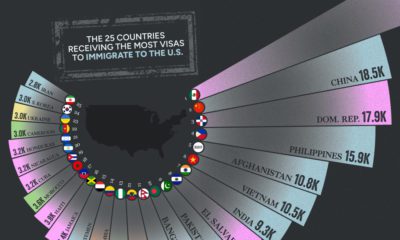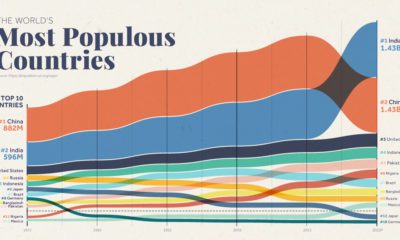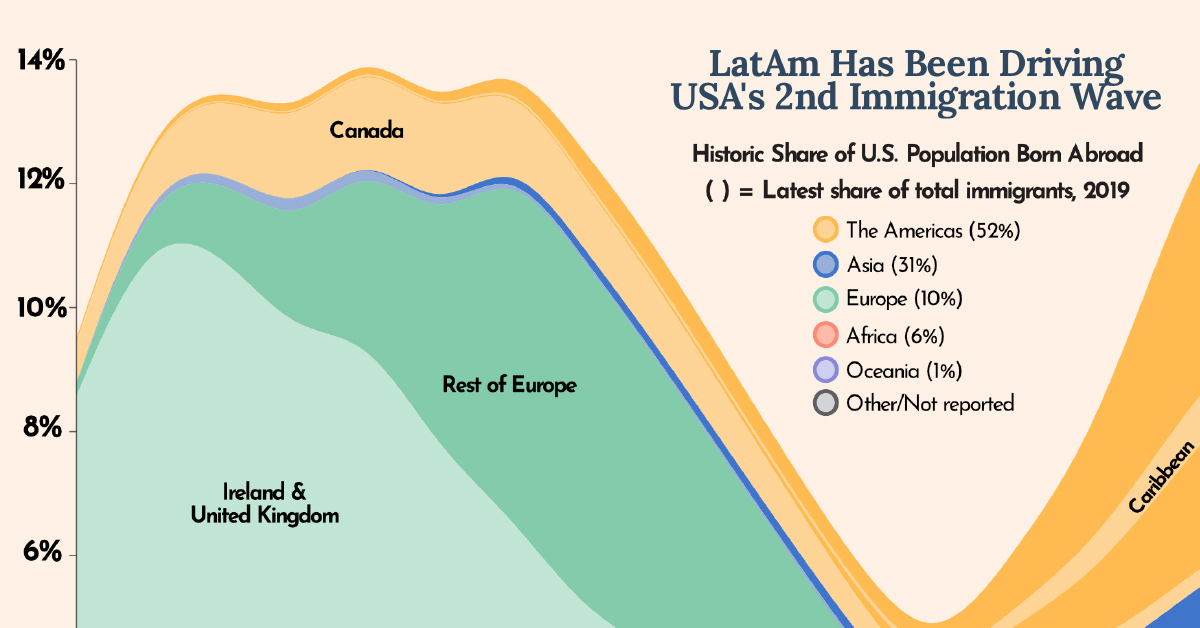The median proportion of foreign-born people in all countries is just over 5%. In countries with a population greater than one million, only four are majority foreign-born, and only eight surpass the one-third mark. Here are the top 20 countries with the highest proportion of immigrants in their populations: Source: UN via World Population Review. Note: Only countries with a population of greater than one million are included. The United Arab Emirates comes out on top for the highest proportion of immigrants in its population. Impressively, the small Middle Eastern nation ranks sixth in the world for total immigrant population (8.7 million people). Other countries on the Arabian Peninsula also rank at the top of this list. In Qatar, current host of the 2022 World Cup, 3-in-4 people are immigrants. The high proportion of foreign workers in the country also results in an extreme demographic skew—approximately 75% of the population of Qatar is male. The one extreme outlier in the region is war-torn Yemen, where only 1.3% of the population are immigrants. Outside the Middle East, Singapore (43%) takes top spot, followed by Australia (30%).
Spotlight on U.S. Immigration
Although the United States is outside the top 20, it still has by far the most immigrants of any other country (50 million vs. 16 million in second-place Germany). About 15% of people in the U.S. are immigrants—numbers which are comparable to the historic high in the late 19th century. The proportion of foreign-born people in the country has been on the rise since the 1970s, and is projected to continue rising in coming decades. Around 2030, immigration is expected to surpass natural increases as a driver of population growth.
Countries with the Lowest Proportion of Immigrants
A few countries are magnets for immigration, while a great many more receive very little immigration. This can simply be due to lack of demand, or because of more extreme circumstances such as war or a failing economy. In other cases, immigration policies may limit the number of people who can migrate to a country. Here are the top 20 countries with the lowest proportion of immigrants in their populations: Cuba has the lowest level of foreign-born people in its population. The Caribbean nation makes it very difficult for foreign nationals obtain permanent residency. China comes in second last. In absolute terms, the million or so immigrants living in China may sound like a lot, but pales in comparison to the overall population of 1.4 billion. Interestingly, Japan–which is the poster child for low immigration–isn’t on the list above. The country’s foreign-born population sits at just over 2%. on Since the 1970s, the region has driven the second wave of U.S. immigration and helped shape the country’s future immeasurably. This is especially clear when looking at Census data listing where people were born. This chart from Latinometrics looks at the history of U.S. immigration considering both documented and undocumented immigration since 1850.
Historical U.S. Immigration
For most of its early history, Europeans drove immigration to the United States. The UK, Ireland, and Germany were especially big sources of American immigrants well into the 20th century. But around the 1960-70s this began to shift, with LatAm countries marking the next wave of U.S. immigration. Here’s a sample of the history of U.S. immigration using select years and regions:
LatAm Immigration
As of 2019, 22.6 million foreign-born people in the U.S. were originally from LatAm countries, with 10.9 million from Mexico alone. Additionally, in 2021 Mexican citizens received the highest number of U.S. immigrant visas in the world at almost 40,600. Immigrant visas are the first step in the process to U.S. green cards and citizenship. And though Asian countries are beginning to make up the majority of U.S. immigrant applicants and permits, other LatAm countries also ranked high in issued permits in 2021:
🇩🇴 Dominican Republic: 17.9K 🇸🇻 El Salvador: 7.8K 🇪🇨 Ecuador: 5.1K 🇨🇴 Colombia: 4.8K
Furthermore, there is also undocumented immigration to consider. According to 2019 figures from Brookings, there are between 10.5-12 million undocumented migrants living in the U.S.—making up just over 3% of the population. Here’s a look at the top five countries in terms of undocumented immigration to the U.S. in 2019, most of which are LatAm countries:
The Future of U.S. Immigration
In the last few years, more and more Asian countries are seeing their citizens leave for the United States. In addition, the knock-on effects of the COVID-19 pandemic and the Russo-Ukrainian War (as well as other global events and crises) could shift U.S. immigration even further away from LatAm. Currently, the U.S. is only permitting small numbers of legal immigrants to enter the country each year, numbering in only the hundreds of thousands. But as birth rates decline, the growth in the foreign-born population will continue to be a much-discussed and important topic for the country’s demographics in the coming years.













